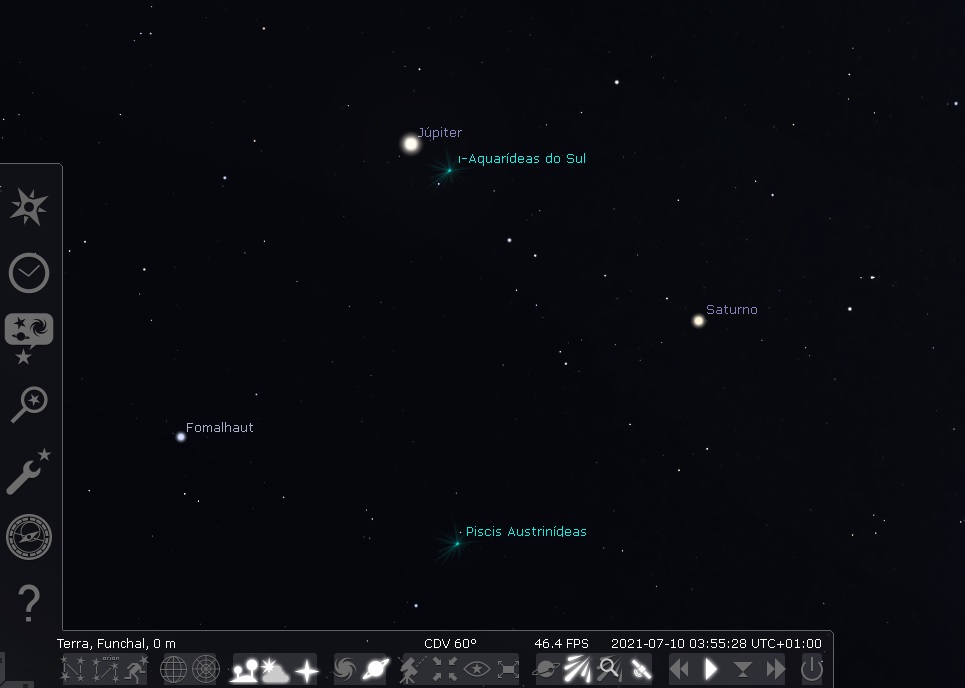Por vezes, ao visualizar o céu durante a noite, passam vários pequeninos pontos brilhantes que atravessam o espaço visível em poucos segundos e que deduzo que sejam satélites. Como li algures, a estação espacial internacional (ISS) viaja a 7 km por segundo, sendo o objecto mais brilhante no céu noturno depois da Lua. Vejo contudo um ponto bastante brilhante no céu que penso não poder tratar-se da ISS uma vez que este move-se juntamente com todos os outros astros no firmamento. Como se chama essa estrela? Se a ISS viaja a tal velocidade e é a coisa mais brilhante no céu depois da Lua, porque vejo passar tantos satélites e nunca vi a estação internacional? A minha dúvida, entre a estação internacional e esta estrela, surgiu, quando numa noite apareceu de repente por baixo desta estrela um ponto suficientemente brilhante que se deslocou no espaço e desapareceu no horizonte mas não muito longe no horizonte, pensei até que fosse o vai-vém espacial!
Esses pontos brilhantes que atravessam o céu em poucos segundos devem ser, regra geral, satélites artificiais. Nalguns casos também podem ser aviões ou estrelas cadentes.
A estação espacial internacional (ISS) é de facto um dos objectos mais brilhantes que podemos ver a atravessar o céu nocturno. Contudo existem milhares de satélites das mais variadas dimensões e apenas uma ISS. Assim é muito mais provável numa qualquer noite observarmos vários satélites a cruzar o céu ao passo que a passagem da ISS não será assim um evento tão regular em relação a um dado ponto da Terra. Para seguir o trajecto da ISS em tempo real pode explorar a página:
https://www.n2yo.com/?s=25544
Pode mesmo procurar para a sua localização geográfica quais serão as datas das passagens para os 10 dias seguintes e, dentre essas, quais as mais favoráveis para a observação.
O objecto brilhante de que fala seria provavelmente o planeta Júpiter. Na imagem abaixo obtida utilizando o programa Stellarium (que pode aceder livremente em que pode aceder em https://stellarium-web.org/) mostra parte do céu para o dia 10 de julho de 2021 cerca das 3h50 da manhã (hora em que foi enviada a sua questão). Nela podemos Júpiter, com Saturno um pouco ao lado. Curiosamente neste campo de visão estavam também previstas chuvas de meteoros pelo que muito provavelmente o objecto que viu deslocar-se nas proximidades de Júpiter seria um meteoro.

Fig. 1
Sometimes, when viewing the night sky, several tiny bright spots pass through a small space in a few seconds, and I deduce that they are satellites. As I read somewhere, the International Space Station (ISS) travels at 7 km/s, being the brightest object in the night sky after the Moon. However, I see a very bright point in the sky that I think can't be the ISS, since it moves along with all the other stars in the sky. What is this star called? If the ISS travels at such a speed and is the brightest thing in the sky after the Moon, why do I see so many satellites passing by and never see the ISS itself? My question, between the ISS and this star, arose, when one night a sufficiently bright point suddenly appeared underneath this star, which moved in space and disappeared below the horizon, but not very far. I even thought it was a space shuttle!
Those bright spots that cross the sky in a few seconds should be artificial satellites. In some cases, they can also be airplanes or shooting stars.
The International Space Station (ISS) is in fact one of the brightest objects we can see crossing the night sky. However, there are thousands of satellites of the most varied dimensions and only one ISS. So, it's much more likely that, on any given night, we will observe several satellites crossing the sky, while the passage of the ISS will not be such a regular event in relation to a given point on Earth. To follow the trajectory of the ISS in real time, you can explore this page:
https://www.n2yo.com/?s=25544
You can even search, for your geographical location, which will be the dates of the passages for the next 10 days and, among these, which are the most favorable for observation.
The bright object you talk about should be the planet Jupiter. The image of Fig 1., obtained using the Stellarium app, which you can freely access at https://stellarium-web.org/, shows part of the sky for July 10th, 2021, at around 3:50 am (which your question should be appropriate for). In it, we can see Jupiter, with Saturn a little to the side. Interestingly, meteor showers were also predicted in this field of view, so most likely the object that you saw moving close to Jupiter would be a meteor.
